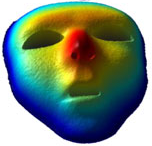Haze limits visibility and reduces image contrast in outdoor images. The degradation varies spatially since it depends on the objects’ distances from the camera. This dependency is expressed in the transmission coefficients, which control the attenuation. Restoring the scene radiance from a single image is a highly ill-posed problem, and thus requires using an image prior. Contrary to methods that use patch-based image priors, we propose an algorithm based on a non-local prior. Our algorithm relies on the assumption that colors of a haze-free image are well approximated by a few hundred distinct colors, which form tight clusters in RGB space. Our key observation is that pixels in a given cluster are often non-local, i.e., spread over the entire image plane and located at different distances from the camera. In the presence of haze these varying distances translate to different transmission coefficients. Therefore, each color cluster in the clear image becomes a line in RGB space, that we term a haze-line. Using these haze-lines, our algorithm recovers the atmospheric light, the distance map and the haze-free image. The algorithm has linear complexity, requires no training, and performs well on a wide variety of images compared to other state-of-the-art methods.
Photometric stereo is widely used for 3D reconstruction. However, its use in scattering media such as water, biological tissue and fog has been limited until now, because of forward scattered light from both the source and object, as well as light scattered back from the medium (backscatter). Here we make three contributions to address the key modes of light propagation, under the common single scattering assumption for dilute media.
-
We show through extensive simulations that single-scattered light from a source can be approximated by a point light source with a single direction. This alleviates the need to handle light source blur explicitly.
-
We model the blur due to scattering of light from the object. We measure the object point-spread function and introduce a simple deconvolution method.
-
We show how imaging fluorescence emission where available, eliminates the backscatter component and increases the signal-to-noise ratio.
Code, Dataset and Presentation
NON-LOCAL IMAGE DEHAZING
Code and dataset.

NON-LOCAL IMAGE DEHAZING
Slides of a 20 minutes talk, given at the Vision Day









